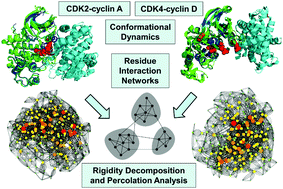Network-based modelling and percolation analysis of conformational dynamics and activation in the CDK2 and CDK4 proteins: dynamic and energetic polarization of the kinase lobes may determine divergence of the regulatory mechanisms
Abstract
The overarching goal of delineating molecular principles underlying differentiation of the activation mechanisms in cyclin-dependent kinases (CDKs) is important for understanding regulatory divergences among closely related kinases which can be exploited in drug discovery of targeted and allosteric inhibitors. To systematically characterize dynamic, energetic and network signatures of the activation mechanisms, we combined atomistic simulations and elastic network modeling with the analysis of the residue interaction networks and rigidity decomposition of the CDK2-cyclin A and CDK4-cyclin D1/D3 complexes. The results of this study show that divergences in the activation mechanisms of CDK2 and CDK4 may be determined by differences in stabilization and allosteric cooperativity of the regulatory regions. We show that differential stabilization of the kinase lobes in the CDK4-cyclin D complexes caused by the elevated mobility of the N-lobe residues can weaken allosteric interactions between regulatory regions and compromise cooperativity of the inter-lobe motions that is required to trigger activating transitions. Network modelling and percolation analysis were used to emulate thermal unfolding and perform decomposition of rigid and flexible regions in the CDK2 and CDK4 complexes. These simulations showed that the percolation phase transition in the CDK2-cyclin A complexes is highly cooperative and driven by allosteric coupling between functional regions from both kinase lobes. In contrast, the imbalances in the distribution of rigid and flexible regions for the CDK4-cyclin D complexes, which are manifested by the intrinsic instability of the N-lobe, may weaken allosteric interactions and preclude productive activation. The results of this integrative computational study offer a simple and robust network-based model that explains regulatory divergences between CDK2 and CDK4 kinases.



 Please wait while we load your content...
Please wait while we load your content...